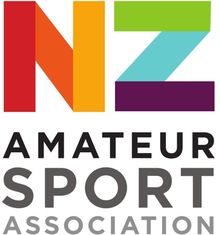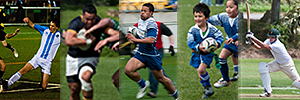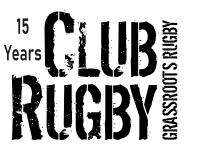Wellington?s champion club teams: Part 2

From the beginning of competitions to right up to the present day, we’ve chosen 25 of the most noteworthy or memorable Wellington club rugby Senior/Premier championship winning teams, Here’s the stories of five club teams that stood out between 1910 and 1929, the first year that the Jubilee Cup was contested.
Oriental 1910
Played 12.Won 10.Lost 1.Drew 1.Points for 155. Points against 58
When Oriental-Rongotai won the Jubilee Cup in 2011, it was the club’s first Senior championship win since 1910 (apart from in World War Two when they temporarily combined with Poneke to win Jubilee Cups in 1943 and 1944). Formed in 1888 after meetings at the Oriental Boating Club and named after founder Gibby Hill’s pleasure craft The Oriental, success has mostly eluded the famous club that amalgamated with Rongotai Old Boys in 1968 and is now based in Miramar.
In 1905 Oriental finished runners-up in five of the six grades that they had teams entered in. In 1908 the Senior A team again finished second but injuries decimated the squad in 1909 and they couldn’t capitalise. Thus 1910 was a special year for the club and they lost just one encounter.
Their game was built around a swift set of backs, with M. Matheson scoring nine tries, H. McLeod seven and R. Pyle five. Halfback Fred Roberts was the All Blacks captain in Australia later that year, while lock/flanker Charlie Gillespie went on to play one Test for the All Blacks against Australia in 1913 aged 30, was a decorated soldier in World War One and was made a Life Member of Ories in 1931.
Wellington’s first great halfback, Fred Roberts, played in Wellington’s first ever Ranfurly Shield winning team against Auckland in 1904 and between 1905 and 1910 he played 52 All Blacks games including 12 Tests (three as captain). He played 58 matches for Wellington after originally playing soccer for two years after leaving school.
Athletic 1911
Played 18.Won 14.Lost 3.Drawn 1.Points for 167. Points against 56
Athletic was the dominant rugby club in Wellington in the years immediately prior to World War One, winning a three-peat of Senior A titles between 1911-13, bracketed as joint winners with Wellington at the outbreak of war in 1914 and winning the modified competition in 1915. They thus won the championship five times in succession, a record that was equalled by Petone in 1971.
Of note is that the 1913 success also meant Athletic became the owners of the Swindale Shield, as was custom at the time when teams won a trophy in three successive years. Forgotten for more than half a century the trophy was discovered in a cupboard at Athletic Park and returned to competition in 1969.
The dynasty was started in 1911 when Wellington’s second oldest club (founded in 1877) were champions for the first time since 1891.

Additionally, Athletic won the Senior seven-a-side tournament and the Charity Cup. The Charity Cup was presented by the WRFU in 1906 to be played between the winner of the Senior Championship and a challenger chosen by the Union. This was replaced by the National Mutual Cup in 1921, which since 1976 has been a lower grade trophy (currently the Senior 2 first-round).
Athletic’s leading player of the time was Nathanial ‘Ranji’ Arthur Wilson, who played 75 times for Wellington between 1906-1920. In the last game of 1914 he captained Wellington to win the Ranfurly Shield off Taranaki and then came back from active service to play in all Wellington’s famous 11 Ranfurly Shield matches in 1920. Of West Indian and English parentage Wilson played 10 Tests for the All Blacks between 1908-1914.
Poneke 1919
Played 15.Won 10.Drew 4.Lost 1.Points for 234. Points against 60
The end of World War One ushered in a brief golden age for Wellington rugby. After a break of five years, Wellington successfully defended the Ranfurly Shield five times in 1919 and famously also took the log o’ wood on tour for the first time, defending it against Canterbury? home (winning 21-8) and away (23-9) in the space of a few weeks.
1919 was also a wonderful year for the Poneke FC, winning the Senior championship for the second straight year. The nature of Poneke’s win was also one of the more thrilling up to then and since. They stormed through the pack with a draw and then a run of five straight victories to finish a point ahead of second placed Athletic.
The defining club match of the 1919 season was on 16 August when Poneke toppled Athletic 14-3 in front of a huge crowd. The following week the Red and Blacks beat Selwyn - who played in a similar green and black strip to today’s Wainuiomata - 12-3; while simultaneously Athletic lost to Petone 5-8. There was then a five-week break in the club competition whilst the bulk of the representative season was played but Poneke returned at the end of September to trounce Petone 32-8 and take the spoils.
Key players in this Poneke team included outside backs Beethoven Algar and Snowy Morris - who had scored five tries in their season opening 51-0 win over Oriental - the Tilyard brothers, Fred, Jim (both All Blacks) and Charlie, and the Shaw brothers, Jack and Sydney.
Petone 1923
Played 15.Won 13.Lost 1.Drew 1.Points for 247. Points against 91
There’s been several famous rugby families associated with Wellington rugby. But there’s perhaps been none more so influential than the Nicholls.? Father Syd founded Poneke and four of his sons, Mark, Harold (Doc), Harry (Ginger) and Geoff played for the Petone Senior A team in 1923 and the first three of them were All Blacks in the 1920s.
Eldest brother and midfielder Doc had been a Wellington representative as far back as 1915 and played his sole All Black match (against the touring NSW side) in 1923. Halfback Ginger was a six match, one Test All Black in 1921 and 1922 and first or second five-eighth Mark was a leading All Black and played 51 matches and 10 Tests spanning 1921-30. Fullback Geoff had been part of a Petone 5th grade side in 1921 that had scored 503 points and conceded 6 all season with Geoff scoring over 200 points himself! A fifth brother, Guy, moved north for work and represented North Auckland for a couple of seasons and a sister, Dulcie, was NZ ladies’ singles tennis champion.
Results-wise in 1923, Petone had won nine and lost one and led the field at the conclusion of the first round when the “top six” played off over five rounds to contest the championship. The “suburbanites” then beat Marist (19-5), Wellington (17-12) and Berhampore (29-9), ahead of a month-long break for representative rugby. Upon return they defeated their nearest challenger Athletic (16-3) to win with a match to spare, which they lost to rivals Poneke (3-11) after 41-game Wellington representative utility back Matt Corner was sent off in the first half.
University 1929
Played 16.Won 13.Lost 2.Drew 1.Points for 217. Points against 120
Students of University rugby will probably point to the previous season, 1928, when they won their maiden championship as being more satisfying. But 1929 was a significant year being the 50th anniversary of the WRFU; and in recognition of such the inaugural Jubilee Cup was contested. Although Petone won the first round, University went on to defend their title playing a consistent team style.
Key attacking players were five-eighth and captain R.H.C Mackenzie and fullback Fred Cormack, who had played for Wairarapa in 1928,goal-kicking fullback F.S Ramson who scored over 100 points throughout the season, and nippy halfback Eric (Tiny) Leys.
This team contributed six players, Mackenzie (as captain), Leys, J.D Mackay, E.Blacker, R.E Dierderich and M. Edgar, to the New Zealand Universities side in their ‘Tests’ against Australia. Wellington College old boy Leys was also selected in the All Blacks for the first tour to Australia in 1929, playing one Test.
University’s first period of glory was short lived. The club fielded almost the exact team in 1930 but plummeted from first to dead last. Has such a sharp fall from grace occurred since? It wasn’t until after World War Two that they regained their status as a leading club.
?
References
Photo credit: ORIENTAL WINS. (Evening Post, 15 August 1910). Alexander Turnbull Library, Wellington, New Zealand. http://natlib.govt.nz/records/18380854
The Evening Post and Dominion newspapers 1910-1929
Mckenzie, D.? Rugby Football in Wellington and Wairarapa, 1868-1910. Publisher unknown. 1911.
Tindill, Eric. History of the Athletic Football Club, 1877-1976. Wellington. Prestige Print, 1977.
Griffin, Don and Gallagher, Peter. True blue: the first 100 years of the Petone Rugby Football Club Incorporated, 1885-1985 Petone. The Club, 1985
Donoghue, Tim. Athletic Park : a lost football ground.? Tim Donoghue Publications in association with the Wellington Rugby Football Union, 1999.
Poneke FC. A Willing Band of Youths:? the history of the Poneke Football Club. Wellington. Poneke Football Club, 1984
Oriental Football Club Inc.? 75th jubilee, 1888-1963. Wellington : Standard Press, 1963.
Anderson, John. Victoria University of Wellington Rugby Football Club : the story of the green and golds, 1902-1987. Wellington. The Club, 1988.
Want to contribute to this website? As we continue to build Club Rugby from the ground up we’re seeking writers and contributors. Opinion articles, match and competition previews and reports, interview articles, videos for our video channel (coming soon) - if it’s about rugby we’ll publish it! Email editor@clubrugby.co.nz for more.
?
Steven White, 19 Mar 2019
Adam Julian, 19 Mar 2019
Steven White, 12 Mar 2019
Adam Julian, 04 Mar 2019
Steven White, 12 Feb 2019








.jpg)





